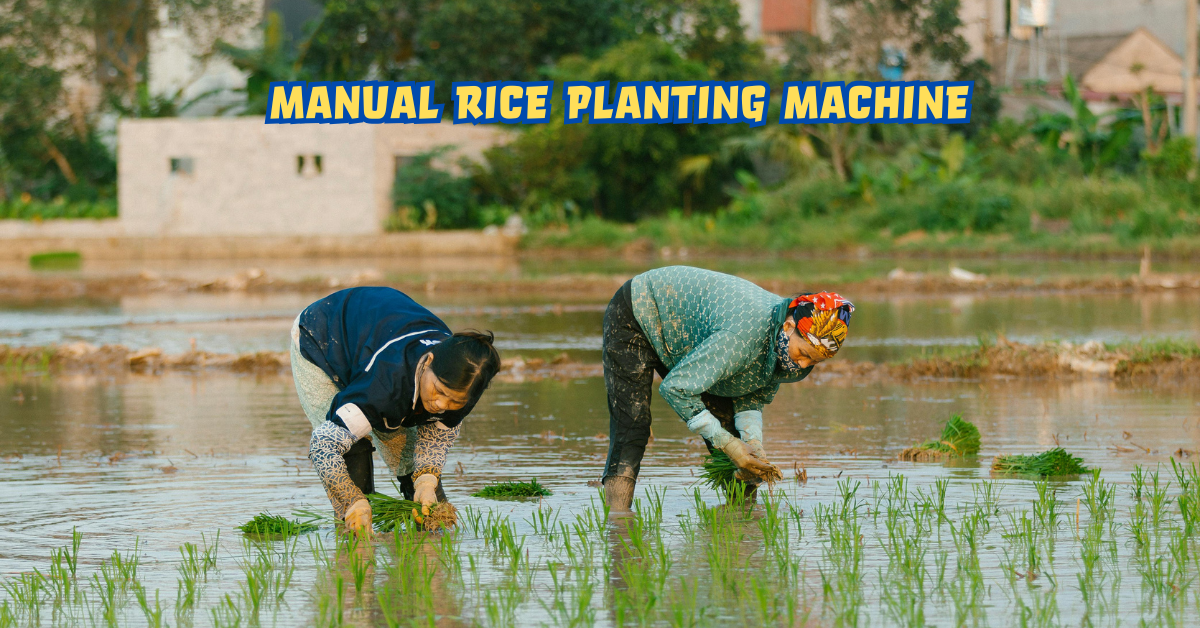Rice is not only a staple food for millions of families across Asia, Africa, and South America, but it is also a crop deeply tied to culture, economy, and livelihoods. Traditional rice planting has always been labor-intensive, requiring farmers to bend over in fields for long hours, placing seedlings one by one into flooded paddies. This method, while effective, has been criticized for its inefficiency, health toll on workers, and the rising unavailability of labor in agricultural regions. In response to these challenges, the manual rice planting machine has emerged as a practical innovation that bridges traditional farming and mechanization.
The manual rice planting machine is a human-operated device designed to speed up transplanting seedlings into paddy fields without relying on expensive fuel-driven equipment. Unlike automated transplanters, these machines are lightweight, portable, and affordable, making them suitable for small-scale farmers. In countries like India, Bangladesh, Vietnam, and Nigeria, where smallholder farmers dominate, this device offers a transformative solution. It reduces labor costs, improves planting precision, and ensures uniform spacing of seedlings, which translates to better crop yields. For farmers struggling with rising costs and labor shortages, manual rice planting machines provide a cost-effective middle ground between hand planting and high-cost mechanization.
Historical Context of Rice Planting
For centuries, rice planting has been done manually, with families or laborers working together during the crucial sowing season. This backbreaking work has traditionally relied on human endurance and time. As urban migration increased, rural communities faced labor shortages during peak seasons, creating an urgent demand for innovative tools. The rise of manual rice planting machines in the late 20th century was not merely about efficiency but survival for many farming families.
These devices offered farmers a way to manage larger fields with fewer hands. Early prototypes were simple, often made of wood and steel, relying on human pushing or pulling to place seedlings. Over the years, improvements were made, introducing lightweight alloys, adjustable handles, and improved planting trays. Today, modern manual rice planting machines blend simplicity with effectiveness, making them vital in the broader narrative of sustainable farming.
How Does a Manual Rice Planting Machine Work?
A manual rice planting machine is essentially designed to replicate the act of transplanting seedlings in a systematic, repetitive manner, reducing effort while maintaining accuracy. The farmer loads rice seedlings into a tray or planting slot on the machine. When pushed or pulled across the paddy field, the machine’s mechanical arms or fingers pick seedlings from the tray and insert them into the soil at regular intervals. This process ensures uniform spacing, which is critical for plant growth and better sunlight and nutrient distribution.
The operation does not require fuel or electricity, relying solely on human force. Some models come with wheels that glide across muddy fields, while others are handheld with direct transplanting tools. The simplicity of the design makes it repairable and adaptable even in rural areas without advanced service facilities. Farmers appreciate these machines for reducing planting time by up to 50 percent compared to traditional hand transplanting.
Advantages of Manual Rice Planting Machines
The popularity of manual rice planting machines lies in their ability to balance affordability and efficiency. Unlike power-driven rice transplanters that cost lakhs of rupees, these machines are accessible to small-scale farmers.
- Labor Efficiency: Reduces reliance on large groups of laborers during peak seasons.
- Time Savings: Accelerates planting speed, allowing farmers to complete sowing before weather conditions shift.
- Cost Reduction: Requires no fuel, lowering operational costs significantly.
- Improved Yields: Ensures even spacing of seedlings, leading to healthier plants and higher productivity.
- Portability: Lightweight and easy to carry, making it ideal for remote villages.
- Durability: Made from rust-resistant materials suitable for wet paddy fields.
As one farmer in Karnataka noted, “With this machine, my family can manage what once required ten workers.”
Limitations and Challenges
While manual rice planting machines have undeniable benefits, they are not without challenges.
- Learning Curve: Farmers unfamiliar with machines may require training to operate them efficiently.
- Field Conditions: Machines perform best in evenly prepared fields; uneven or stony paddies reduce effectiveness.
- Speed vs. Power Machines: While faster than hand planting, they are slower compared to engine-driven transplanters.
- Seedling Preparation: Requires seedlings grown in specific mat-type nurseries for smooth functioning.
- Durability Concerns: Cheaper versions may wear out quickly, especially when used intensively.
Despite these challenges, manual rice planting machines continue to gain acceptance because they offer a sustainable option for regions where high-end mechanization is impractical.
Types of Manual Rice Planting Machines
Manual rice planting machines come in various models, each designed to suit different scales of farming.
Table 1: Types of Manual Rice Planting Machines
| Type | Features | Suitability |
|---|---|---|
| Handheld Transplanters | Compact, low-cost, seedling inserted manually per stroke | Very small fields, individual farmers |
| Row Transplanters | Wheel-based, plants multiple rows simultaneously | Small to medium fields |
| Tray-Based Push Machines | Seedlings loaded in trays, pushed across field automatically | Medium farms, faster planting |
| Adjustable Finger Machines | Adjustable arms to control spacing and depth | Farmers focused on yield optimization |
Each model offers trade-offs between cost, speed, and ease of use, giving farmers flexibility depending on their resources.
Price of Manual Rice Planting Machines
In countries like India, the price of manual rice planting machines depends on material, brand, and features.
Table 2: Price Range of Manual Rice Planting Machines in India
| Category | Price Range (INR) | Notes |
|---|---|---|
| Basic Handheld Models | ₹2,000 – ₹4,000 | Affordable, minimal features, suitable for very small plots. |
| Standard Row Transplanters | ₹6,000 – ₹12,000 | Popular among small-scale farmers. |
| Advanced Push Models | ₹15,000 – ₹25,000 | Higher efficiency, multiple rows at once. |
| Custom/Imported Versions | ₹30,000 – ₹50,000+ | Specialized machines, often with advanced durability. |
While these prices are modest compared to motorized alternatives, the investment remains significant for marginal farmers. Government subsidies and farmer cooperatives often play a crucial role in making these machines more accessible.
Impact on Labor and Rural Economy
One of the biggest impacts of manual rice planting machines is the reduction in labor demand during transplanting season. Traditionally, transplanting required dozens of workers, often leading to wage hikes and disputes. By using machines, farmers reduce dependency on seasonal labor. This shift has both positive and negative consequences. Farmers benefit from lower costs, but rural workers may lose seasonal jobs. To balance this, some communities adopt cooperative models, where machines are shared across villages, ensuring fair distribution of both work and income.
The broader economic effect includes faster planting, which results in timely harvests and potentially higher incomes. Additionally, reduced drudgery for women—who often participate heavily in rice planting—is a critical social benefit.
Environmental Considerations
The manual rice planting machine indirectly supports environmental sustainability. By ensuring uniform spacing, it reduces seed wastage and improves nutrient uptake efficiency. This can lower the demand for excessive fertilizers and water. Unlike motorized transplanters, manual machines produce no emissions and have a far smaller carbon footprint. In regions facing climate challenges, such low-impact solutions align with sustainable agricultural practices. However, they also require well-prepared fields, meaning traditional practices of puddling and land leveling remain essential.
The Future of Manual Rice Planting Machines
The demand for manual rice planting machines is expected to grow in smallholder economies. Innovations are already underway, such as machines with ergonomic handles, lightweight composite materials, and modular parts that make repairs easier. Governments are also including these machines in subsidy programs, recognizing their role in bridging the mechanization gap.
Digital agriculture platforms are beginning to feature manuals, tutorials, and financing schemes for these machines, making adoption easier. The future may even see hybrid models that combine manual operation with small battery-assisted mechanisms, giving farmers greater efficiency without high fuel costs.
Conclusion
The manual rice planting machine represents more than just a tool; it is a symbol of agricultural adaptation. For small-scale farmers in Bangalore, Bihar, Vietnam, or Nigeria, it is not about luxury but survival and sustainability. By reducing dependence on labor, cutting costs, and improving productivity, this machine addresses some of the most pressing issues in modern rice farming.
Its limitations remind us that technology is only effective when matched with training, field preparation, and farmer readiness. While it cannot replace fully mechanized solutions in large-scale farming, it fills a critical gap for millions of farmers worldwide. As agriculture faces challenges of climate change, migration, and economic stress, the manual rice planting machine stands out as a low-cost, high-impact innovation that reshapes rural life.
As one agricultural expert once said, “Innovation in farming doesn’t always mean bigger machines; sometimes it means simpler ones that respect the farmer’s reality.”
FAQs on Manual Rice Planting Machine
1. What is the average price of a manual rice planting machine in India?
Prices range from ₹2,000 for basic handheld devices to ₹25,000 or more for advanced multi-row push models.
2. How much faster is a manual rice planting machine compared to hand planting?
It can cut planting time by nearly 50 percent, depending on field conditions and operator skill.
3. Can manual rice planting machines be used in all paddy fields?
They work best in well-prepared, leveled, and puddled fields. Uneven or rocky fields reduce efficiency.
4. Do governments provide subsidies for buying these machines?
Yes, many state governments and agricultural agencies offer partial subsidies to promote mechanization for small farmers.
5. Are manual machines suitable for large farms?
They are better suited for small to medium fields. For large-scale farms, motorized or automated transplanters are more efficient.











